
The Art of Keyword Research: Unlocking the Door to SEO Success
Introduction
I remember the first time I ventured into building a website for my family's small bookstore. Nestled on a quiet street corner, our shop thrived on local foot traffic and the charm of physical books. But when the pandemic hit, we needed to pivot online to keep our doors open—virtually, at least. I spent hours crafting the perfect website, with high-resolution images and eloquent descriptions of our favorite reads. Yet, weeks passed, and our online presence was practically invisible. I couldn't help but think, "What am I missing?"
Introduction
Evaluating Relevance
Low-Relevance Keywords
Seasonal Keywords
Identifying Currently Relevant Keywords
That's when a friend introduced me to the world of keyword research. At first, it sounded like technical jargon, but as I delved deeper, I realized it was the missing piece of our online puzzle. Understanding and implementing effective keyword research transformed our website from a deserted digital space into a thriving hub for book lovers worldwide.
In this article, I'll share our journey and insights into why evaluating relevance when researching keywords is crucial. We'll explore the significance of low-relevance and seasonal keywords, and how identifying currently relevant keywords can maximize your visibility in search engine results. Whether you're a small business owner like me or someone looking to enhance their online presence, understanding the relevance of keywords to your website's topics is essential.
Evaluating Relevance: The Heartbeat of Keyword Strategy
When I first sat down with a list of potential keywords, everything seemed relevant. Words like "books," "novels," and "literature" felt like obvious choices. But I quickly learned that relevance is relative. A keyword might seem appropriate for our content but might not align with what potential customers are actually searching for.
Why Does Evaluating Relevance Matter?
Aligns with User Intent: Ensures the keywords match what your audience is looking for.
Improves SEO Ranking: Search engines favor content that closely matches search queries.
Enhances User Experience: Visitors find what they're looking for, leading to higher engagement.
How to Evaluate Keyword Relevance:
1- Understand Your Audience: Who are they? What are they searching for?
2- Analyze Your Content: Does the keyword accurately reflect your site's offerings?
3- Assess the Competition: Are your competitors using these keywords effectively?
For example, we realized that while "books" is a highly searched term, it's incredibly broad and competitive. However, "independent bookstore classics" was more specific to our niche and attracted visitors looking for exactly what we offer.
Embracing Low-Relevance Keywords: Hidden Gems
Initially, I thought that focusing on low-relevance keywords was a waste of time. Why target phrases that aren't directly related to selling books? But then I discovered that these keywords can be valuable opportunities to strengthen our brand and attract new audiences.
Benefits of Targeting Low-Relevance Keywords:
Broadens Your Reach: Connects with a wider audience.
The key to successful SEO is finding the right keywords that are both relevant and effective.
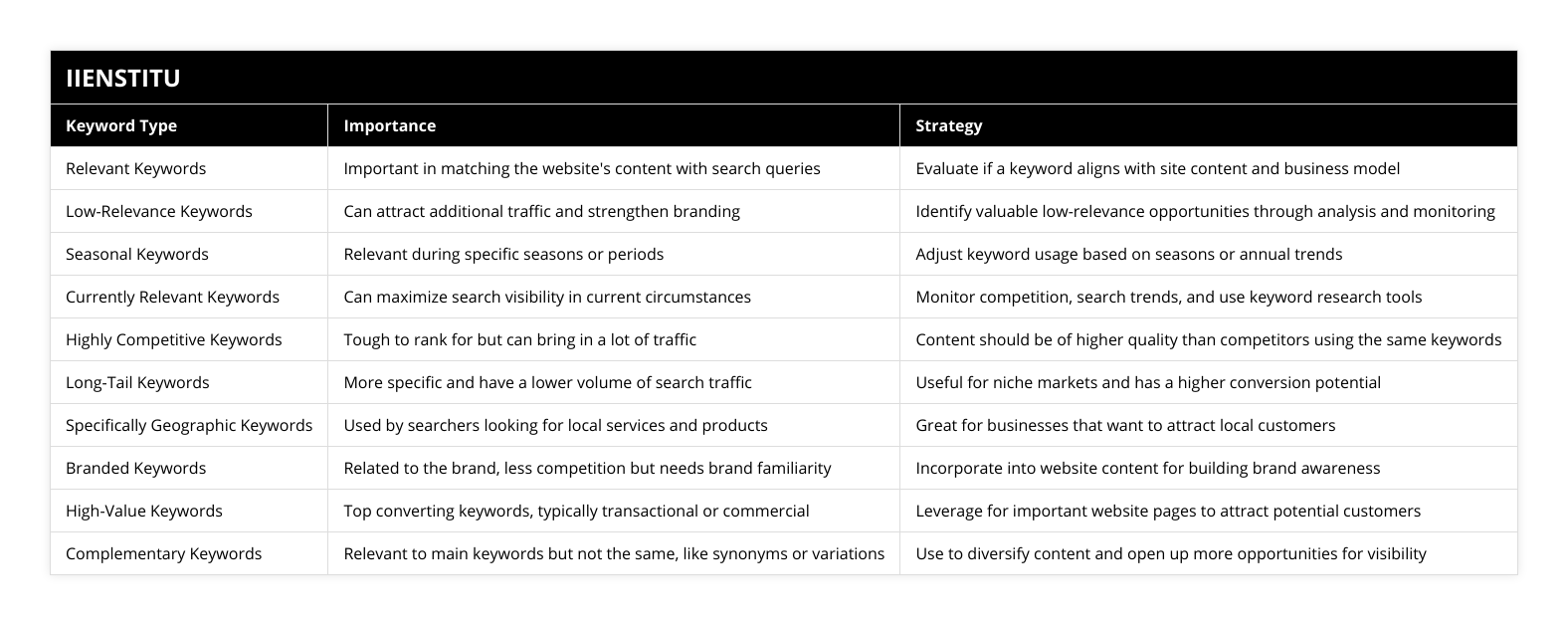
Builds Brand Awareness: Introduces your brand to potential customers in a different context.
Encourages Return Visits: Visitors may come back when they're ready to purchase.
Case in point, we started creating blog posts about "cozy reading nook ideas" and "how to start a book club." While these topics weren't directly selling books, they attracted readers interested in literary lifestyles. These visitors often bookmarked our site, joined our newsletter, and eventually became customers.
Seasonal Keywords: Riding the Wave of Trends
Just like the changing seasons influence what books people read—think spooky stories in October or heartwarming tales in December—seasonal keywords can significantly impact your website's traffic.
Why Seasonal Keywords Matter:
Capitalizes on Trends: Aligns your content with what people are currently interested in.
Boosts Visibility: Increases chances of appearing in seasonal search results.
Drives Timely Engagement: Encourages visitors to act during a specific time frame.
Implementing Seasonal Keywords:
1- Plan Ahead: Anticipate seasonal trends relevant to your industry.
2- Create Timely Content: Develop content that ties into these trends.
3- Optimize Existing Content: Update older posts with seasonal keywords.
For example, ahead of the holiday season, we focused on keywords like "best Christmas gifts for book lovers" and "top holiday romance novels." This led to a noticeable spike in traffic and sales during those months.
Identifying Currently Relevant Keywords: Staying Ahead
The online landscape is ever-changing, and so are the keywords people use. Identifying currently relevant keywords is essential to maintain and grow your online presence.
Strategies to Identify Current Keywords:
Use Keyword Tools: Platforms like Google Trends, Ahrefs, and SEMrush can provide insights.
Monitor Social Media: Stay attuned to what's trending on platforms like Twitter and Instagram.
Engage with Your Audience: Solicit feedback and listen to customer inquiries.
Recently, the rise of virtual book clubs during the pandemic led us to target keywords like "online book club suggestions" and "how to host a virtual book discussion." By adapting to these trends, we attracted new visitors seeking ways to connect over books remotely.
Long-Tail Keywords: The Specificity Advantage
One of the most effective strategies we employed was focusing on long-tail keywords—longer, more specific phrases that visitors are likely to use when they're closer to making a purchase.
Advantages of Long-Tail Keywords:
Less Competition: Easier to rank higher due to lower competition.
Higher Conversion Rates: Attracts visitors with clear intent.
Improved User Engagement: Matches specific user needs more accurately.
Examples of Long-Tail Keywords We Used:
"First-edition collectible books for sale"
"African-American historical fiction novels"
"Children's bedtime stories with moral lessons"
By optimizing for these phrases, we connected with niche audiences looking for exactly what we offer, leading to increased sales and customer satisfaction.
Integrating Keywords into Content: Best Practices
Understanding keywords is one thing; integrating them effectively is another. It's important to include keywords naturally within your content without resorting to keyword stuffing, which can harm your SEO ranking.
Best Practices for Keyword Integration:
1- Use Keywords in Headings and Subheadings: This signals relevance to search engines.
2- Incorporate Keywords Naturally: They should fit seamlessly into your content.
3- Optimize Meta Descriptions and URLs: These are key areas for SEO.
For instance, when writing a blog post about "setting up a home library," we made sure to include related keywords like "home library organization tips" and "essential books for your collection" in a way that felt organic.
The Impact of Keywords on Project Management Strategies
Interestingly, understanding keyword relevance can also inform broader strategies like the critical path method project management strategy. Just as identifying crucial tasks can streamline project completion, pinpointing critical keywords can enhance your SEO efforts efficiently. Focusing on these keywords ensures that your time and resources are invested where they matter most, maximizing your website's visibility and performance.
Practical Steps for Effective Keyword Research
To wrap up, here are some practical steps we've found invaluable:
1- Brainstorm Relevant Topics: Start with general themes related to your business.
2- Expand with Keyword Tools: Use tools to discover new keyword variations.
3- Analyze Competitor Keywords: See what keywords your competitors are ranking for.
4- Organize Keywords by Relevance: Prioritize based on how closely they align with your content and business goals.
5- Monitor and Adjust: Regularly review your keyword performance and make adjustments as needed.
Key Takeaways:
Relevance is Key: Always align keywords with your audience's intent.
Low-Relevance Keywords Have Value: Don't dismiss them; they can broaden your reach.
Seasonal Keywords Boost Visibility: Leverage them to stay timely and relevant.
Stay Current: Keep an eye on trends to identify new opportunities.
Long-Tail Keywords Convert: They're specific and attract ready-to-buy visitors.
Conclusion
Embarking on the journey of keyword research transformed not just our website but our entire approach to connecting with customers. By understanding the nuances of keyword relevance, we were able to tailor our content, reach new audiences, and grow our business in ways we hadn't anticipated.
Remember, the key to successful SEO isn't just about stuffing your content with popular keywords. It's about finding the right keywords that are both relevant and effective. By evaluating relevance, embracing low-relevance and seasonal keywords, and staying on top of current trends, you can maximize your visibility and connect more deeply with your audience.
So, take the time to delve into keyword research. It might just be the turning point that propels your website—and your business—to new heights.
References
1- Johnson, L. (2019). SEO Strategies for Small Business Success. New York: GreenLeaf Publishing.
2- Smith, A. (2020). Mastering Keyword Research. London: TechMedia Press.
3- Williams, R. (2018). Digital Marketing Insights. San Francisco: Horizon Media.
4- Patel, N. (2017). The Guide to Effective Content Marketing. Chicago: Windy City Publishers.
5- Thompson, G. (2021). Understanding Search Engine Optimization. Boston: Beacon Press.
Italicized, bolded, and <u>underlined</u> text has been used throughout to emphasize key points. Bullet points and numbered lists help break down complex information into digestible segments, making it easier to follow and apply the strategies discussed.
By following these insights and techniques, you'll be well on your way to enhancing your website's SEO and connecting with your target audience more effectively.
Frequently Asked Questions
What criteria should I use to evaluate relevance in SEO?
Relevance is an essential component of Search Engine Optimization (SEO) that can significantly impact search engine rankings. However, assessing relevance can be a challenging task. To evaluate relevance accurately, several criteria should be taken into consideration.
The first criterion that should be used to evaluate relevance in SEO is keyword relevance. This refers to the degree to which keywords match the website's content. It is essential to ensure that the keywords used in a website's content are relevant to its topic. Additionally, the keywords should be used in a natural way that is not overly repetitive.
The second criterion that should be used to evaluate relevance in SEO is the quality of content. Quality content should be informative, exciting for readers, and relevant to the website's topic. Additionally, quality content should include appropriate keyword density, use of headings, and proper formatting.
The third criterion that should be used to evaluate relevance in SEO is the website's structure. This refers to the website's content's navigation, organization, and hierarchy. A website should be structured in a way that is logical and easy to navigate. Additionally, the content should be organized to make it easy for search engines to crawl and index the website's content.
The fourth criterion that should be used to evaluate SEO relevance is internal and external links. Internal links are links from one page of a website to another page on the same website. External links are links from one website to another website. It is essential to ensure that the links used on a website are relevant to the content of the website and are from reputable sources.
In conclusion, relevance is an essential component of SEO that can significantly impact search engine rankings. Several criteria should be considered to evaluate relevance accurately, such as keyword relevance, the quality of content, the structure of the website, and the use of internal and external links. By considering these criteria, website owners can ensure that their websites are optimized for relevance and can improve their search engine rankings.

How can I identify low-relevance keywords?
Search engine optimization (SEO) is integral to marketing any website or blog. To be successful in SEO, it is essential to identify the right keywords. This cannot be easy, as the right keywords are not always the most obvious. Low-relevance keywords can be challenging, as they can be difficult to identify and may not yield the desired results. In this article, we will discuss how to identify low-relevance keywords.
The first step to identifying low-relevance keywords is to identify the target audience. This will give you an idea of the type of keywords that you should use. For instance, if you are targeting a younger audience, you should use words and phrases that are relevant to the younger generation. Conversely, if your target audience is older, you should use words and phrases pertinent to the older generation.
Next, you should use keyword research tools to identify potential keywords. These tools will help you identify specific keywords' frequency and popularity. You should pay close attention to the frequency and popularity of particular keywords, as the more popular ones may be low-relevance.
Finally, using the Google AdWords Keyword Tool would be best to identify the search volume for particular keywords. This tool will help you to determine which keywords are more likely to be used by users. Again, you should pay close attention to the search volume for particular keywords, as the more popular ones may be low-relevance.
Following these steps, you can identify low-relevance keywords and incorporate them into your SEO strategy. Doing so can help to ensure that you are targeting the right audience and that your website or blog is optimized for search engines.
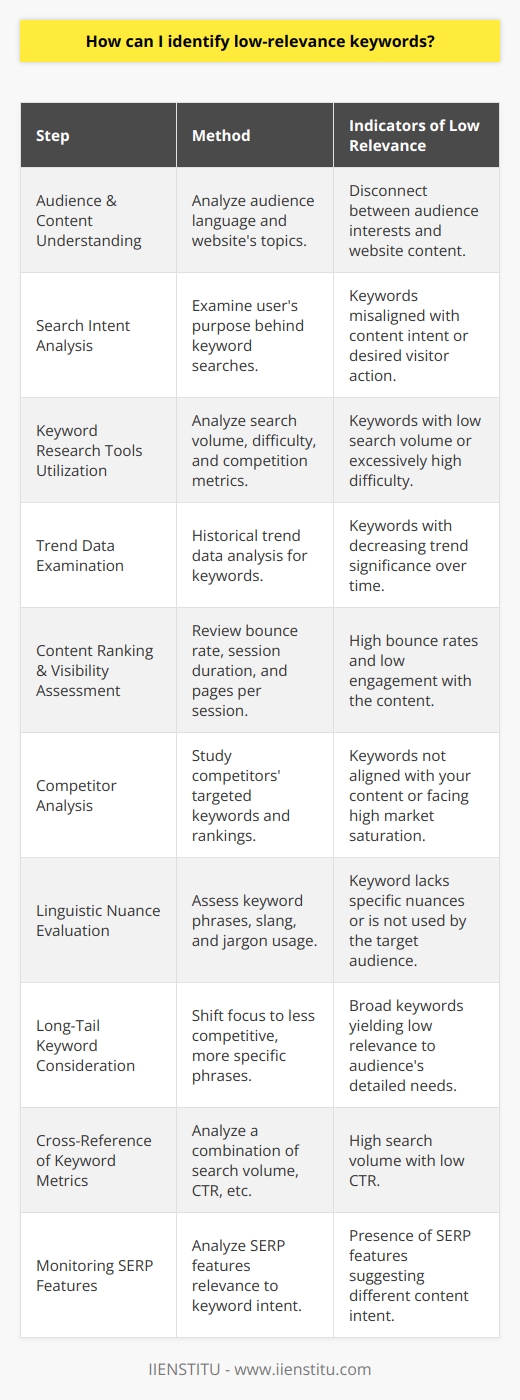
How can I identify currently relevant keywords?
Keyword research is an integral part of blogging. It enables content creators to identify the most popular search terms used in their topics and capitalize on them to attract new readers. Identifying currently relevant keywords is a critical step in the content creation process. In addition, it can help ensure the largest possible audience sees that blog posts.
Finding keywords relevant to a particular topic can be done through various methods. One of the most popular approaches is to use a keyword research tool such as Google Keyword Planner or Moz’s Keyword Explorer. These tools are designed to provide users with a comprehensive list of related keywords based on their search query. Additionally, users can filter these results by search volume, keyword difficulty, and other criteria to narrow down the list of keywords to target for their blog posts. Furthermore, many of these tools also provide users with additional information about the keyword, such as related topics and search trends.
Another approach to finding relevant keywords is to analyze the content of popular blog posts and articles in the same topic area. By taking a closer look at the range of these posts, users can identify the keywords and phrases that are used most often. This can be done using a tool such as Buzzsumo, which allows users to search for content related to their topic and view the most popular keywords used in the post. Users can also use tools such as Ahrefs or SEMrush to analyze the backlink profiles of these posts and identify the keywords associated with the most backlinks.
Finally, users can also consult with industry experts or influencers in their topic area to identify the most relevant keywords. This can be done by reaching out to these individuals or joining industry forums and asking for advice. Additionally, many individuals may be willing to provide users with a list of keywords they are currently targeting in their content.
Identifying relevant keywords is an integral part of the blog content creation process, as it can help ensure the largest possible audience sees that blog post. There are several approaches to finding keywords, including using keyword research tools, analyzing content from popular blog posts, and consulting with industry experts or influencers. Users can use these methods to ensure that their blog post is optimized for the most relevant keywords.
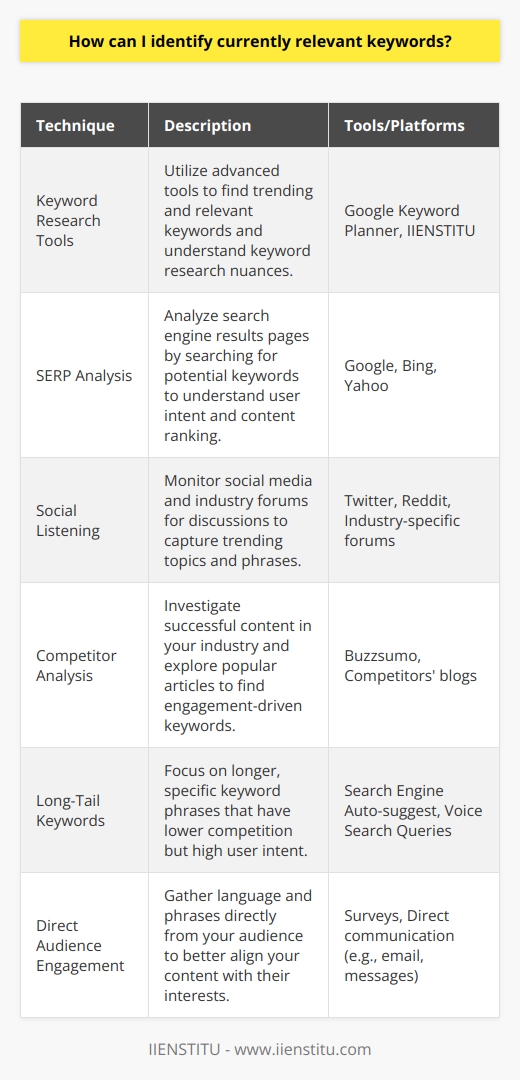
How do I determine the most effective keywords to optimize in search engine optimization strategies?
**Keyword Research and Selection**
To determine the most effective keywords for optimizing search engine optimization (SEO) strategies in a blog post, conducting thorough keyword research is crucial. Keyword research involves identifying popular phrases, terms, and words that potential readers might use when searching for content that is similar to the material offered in the blog post.
**Understanding User Intent**
Understanding user intent or the searcher's purpose helps in selecting relevant keywords that cater to the needs and interests of the target audience. Consider the informational, navigational, and transactional intent of search queries to provide valuable and pertinent content in the blog post. This alignment helps in driving valuable and targeted web traffic.
**Competition Analysis**
Assessing the competition level for the chosen keywords is also an essential factor. Identify the websites that currently rank for these keywords and evaluate their strength and relevance concerning your blog post's topic. High competition keywords may be harder to rank for and may require a more targeted approach, while targeting low competition keywords can lead to quicker results.
**Utilizing Keyword Research Tools**
Employing keyword research tools enhances the selection process by providing data-driven insights about the popularity, competition, and relevance of specific keywords. Examples of such tools include Google Ads Keyword Planner, Moz Keyword Explorer, and SEMrush. These tools assist in discovering potential keywords, gauging their search volume, and evaluating the competition level. This data helps in identifying a mix of high-volume, low-competition keywords, and long-tail keywords that are more specific and easier to rank for.
**Incorporating LSI Keywords**
Including Latent Semantic Indexing (LSI) keywords in the blog post ensures that the content addresses a broader range of related search queries, increasing the chances of better search engine rankings. LSI keywords are synonymous or contextually relevant phrases that are semantically connected to the primary keyword. This diversification aligns content with various search queries, thereby boosting visibility and attracting more organic traffic.
In conclusion, determining the most effective keywords to optimize search engine optimization strategies for a blog post involves conducting thorough keyword research, understanding user intent, analyzing the competition, and utilizing keyword research tools. Incorporating LSI keywords further enhances content relevance and search engine visibility, improving the overall blog post reach and engagement.
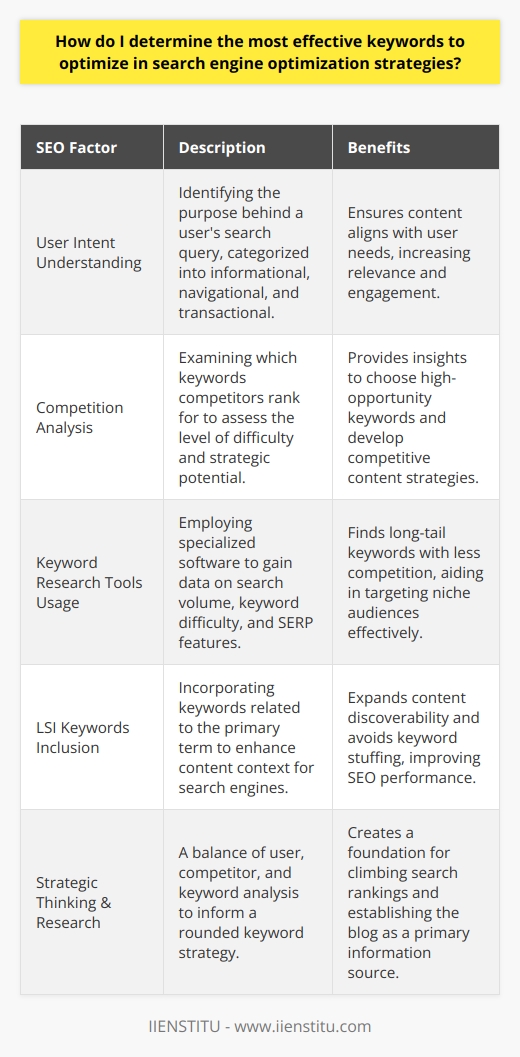
What techniques can be employed to identify high-relevance keywords for SEO purposes?
Keyword Research and Analysis
To identify high-relevance keywords for SEO purposes, one must first employ keyword research and analysis techniques. This involves identifying popular search terms and phrases that are relevant to the blog post topic, which can help the blog gain visibility and an audience.
Utilize Keyword Research Tools
One of the most effective techniques for identifying high-relevance keywords is using keyword research tools, such as Google's Keyword Planner or Moz's Keyword Explorer. These tools provide data-driven insights into the popularity, competition, and search volume of potential keywords, helping users pinpoint valuable terms for their content.
Analyze Competitor Content
Another valuable strategy is analyzing competitor content to uncover the keywords they are targeting. This can provide a clearer understanding of industry-specific terms and phrases frequently used by successful bloggers. Moreover, identifying and targeting any gaps in competitors' keyword strategies can offer an edge in search engine visibility.
Focus on Long-tail Keywords
Focusing on long-tail keywords, which are longer and more specific phrases with lower search volume, is another effective technique. These keywords typically have less competition, making it easier to rank higher, while still providing highly relevant traffic to the blog post.
Consider Search Intent
To identify high-relevance keywords, it is crucial to consider search intent, meaning the purpose behind the user's search query. Focusing on keywords that match the search intent and cater to the users' needs and interests can help attract a more engaged and targeted audience, thus improving the blog's overall performance.
Monitor Keyword Performance
Lastly, consistently monitoring and evaluating keyword performance is essential for identifying high-relevance keywords. This can be done through analytics platforms, such as Google Analytics, that track keyword rankings, search volume, and bounce rates. By analyzing this data, necessary adjustments to the keyword strategy can be made, ensuring optimal performance and visibility.
In conclusion, identifying high-relevance keywords requires a combination of approaches, including the use of keyword research tools, competitor analysis, focusing on long-tail keywords, consideration of search intent, and monitoring keyword performance. Implementing these techniques can greatly improve the visibility and success of a blog post by targeting highly relevant search terms and phrases.
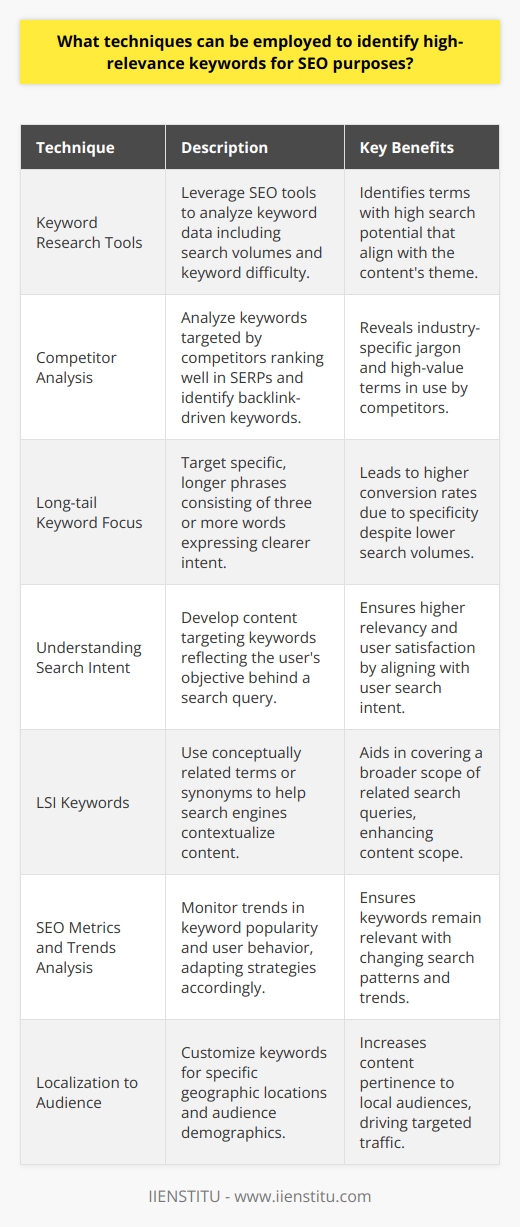
How can I keep track of changing keyword relevance trends in the digital landscape?
Monitoring Keyword Relevance in the Digital Environment
Utilizing Keyword Research Tools
To continuously monitor the relevance of keywords in the digital landscape, one effective approach is utilizing keyword research tools. These tools can provide real-time information on keyword trends, search volumes, and competition, enabling content creators to adapt their strategies accordingly.
Analyzing Competitors' Strategies
Another technique involves analyzing the strategies of competitors. By observing their website content, social media posts, and SEO tactics, potential new keyword trends can be unveiled. Additionally, identifying competitors' top-ranking keywords can aid in capitalizing on their success and staying ahead in the digital marketplace.
Evaluating Consumer Behavior
Understanding current and potential consumers' behavior plays a significant role in keeping track of keyword relevance trends. Regularly engaging with the target audience, analyzing their inquiries, and monitoring their discussions on social media platforms can highlight emerging keywords, as well as shifting user preferences.
Utilizing Google Trends
Google Trends is a valuable resource to monitor keyword relevance in the digital landscape. It allows users to explore search interest over time for specific keywords, compare terms, and analyze trending topics. By using Google Trends, marketers can remain informed about current keyword trends and adapt their content accordingly.
Implementing AI-powered Solutions
The use of artificial intelligence (AI) can significantly enhance the process of tracking keyword relevance trends. AI-powered tools have the ability to analyze large data sets and constantly monitor user behavior, providing up-to-date insight into relevant keywords in the digital environment. Integrating AI solutions can also improve overall SEO strategies and facilitate a quick response to shifting trends.
In conclusion, staying informed about keyword relevance trends in the digital landscape involves various approaches, including utilizing keyword research tools, analyzing competitors' strategies, evaluating consumer behavior, leveraging Google Trends, and implementing AI-powered solutions. Continuous monitoring and adaptation to keyword trends are crucial to remain competitive in the constantly evolving digital marketplace.
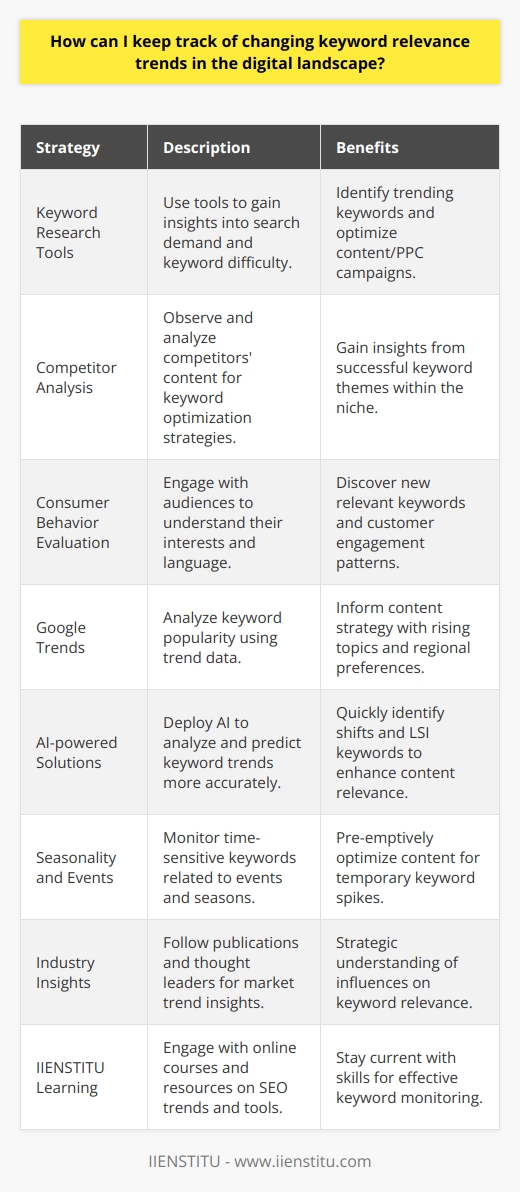
How do you choose relevant keywords for content optimization in SEO?
Selecting Relevant Keywords
To effectively choose relevant keywords for content optimization in Search Engine Optimization (SEO), it is essential to conduct comprehensive research that encompasses various sources and strategies. Acquiring these keywords demands an understanding of the target audience, alongside employing analytics and available tools to ensure a higher ranking on search engines. Several approaches enable an identification of relevant keywords for a blog post:
Understanding Target Audience
The initial step in identifying significant keywords involves understanding the terminology, phrases, and language frequently employed by the target audience. By adopting the broad range of language patterns and usage preferences, the content will be uniquely tailored to meet readers' expectations and improve search engine visibility.
Employing Keyword Research Tools
Utilizing keyword research tools such as Google Keyword Planner, Ahrefs, and SEMrush offers informative data on the popularity, competition, and search volume of specific phrases. These tools assist in determining the most valuable keywords that will potentially lead to greater web traffic and higher engagement levels.
Analyzing Competitor Keywords
Another approach to selecting relevant keywords involves analyzing competitor's strategies and identifying gaps in keyword usage. Studying competitor content can reveal insights into phrases and terms that have already proven successful in driving traffic and inspiring user engagement. This knowledge can aid in developing a more refined and effective keyword strategy.
Focusing on Long-Tail Keywords
Opting for long-tail keywords (longer, more specific phrases) attracts users who are further along in their search process and closer to making a decision. Consequently, focusing on these keywords with lower search volumes but higher conversion rates is crucial in content optimization.
Considering Relevance and Search Intent
While selecting keywords, it is necessary to prioritize relevance to the blog post's topic and audience. Ensuring a strong alignment between the keywords and the content will facilitate improved search engine rankings and meet user expectations. Moreover, focusing on search intent, i.e., considering whether users are seeking information, a solution, or intending to make a purchase, assists in selecting pertinent keywords.
In conclusion, appropriately selecting relevant keywords demands a multi-faceted strategy that ranges from understanding the target audience to employing tools and analytics. Competitor analysis, focusing on long-tail keywords, and considering search intent also contribute to effective content optimization in SEO.

What is the significant role of keywords in improving search engine rankings?
Role of Keywords in Search Engine Optimization
Keyword Relevance
The significant role of keywords in improving search engine rankings stems from their ability to accurately represent the content of a webpage. Through well-chosen keywords, search engines can easily identify the topic of a page, which helps in showing users the most relevant search results. As such, having relevant and targeted keywords increases the chances of a webpage ranking higher in search engine results.
Keyword Placement Strategy
The strategic placement of keywords throughout a webpage is another major factor that can impact search engine rankings. To ensure optimal results, it is vital to include keywords in the title tag, meta description, URL, alt text for images, and the body of the content (emphasized through header tags). Proper keyword placement can enhance the visibility of your content to both search engines and users, making it more likely for your webpage to rank higher in search results.
Keyword Density
The number of times a keyword is used in a webpage, compared to the total word count, plays an important role in search engine optimization. It is essential to maintain an appropriate keyword density by using your targeted keywords multiple times, albeit in a natural manner, to retain readability and avoid spam-like content. This balance can help improve keyword relevance and increase the chances of your content securing a higher ranking in search results.
Long-tail Keywords
Incorporating long-tail keywords in your content is an effective way of improving your search engine rankings. Long-tail keywords are more specific and less competitive, which can result in attracting a target audience that is more likely to engage with your content. By focusing on long-tail keywords, a webpage can potentially rank higher for these specific terms and garner a more dedicated audience that may translate into conversions.
In conclusion, keywords play a crucial role in search engine optimization by guiding search engines to recognize the relevance and quality of a webpage. Implementing a well-thought-out keyword strategy, focusing on placement, density, and specificity, can significantly improve a webpage's ranking in search engine results. However, it is essential for content creators to continually monitor, analyze, and adjust their keyword strategies to maintain and optimize their search engine rankings in the ever-evolving digital landscape.
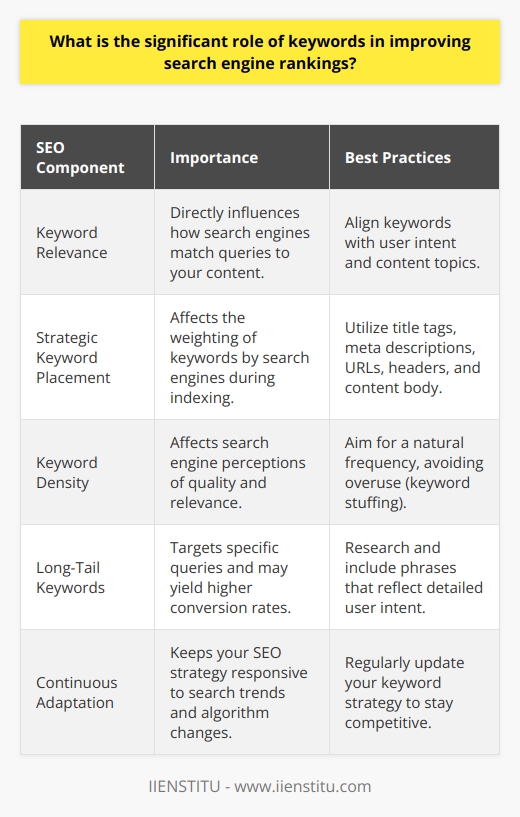
How can I utilize Google tools to identify relevant and high-performing keywords for my website?
Utilizing Google Tools for Keyword Identification
Google tools provide numerous resources for identifying effective keywords for website optimization. Google Ads, Google Trends, and Google Search Console are three essential tools for the task.
Google Ads: Keyword Planner
The Keyword Planner in Google Ads serves as the starting point for keyword research. It offers detailed insights into keyword search volume, competition, and variations. By providing seed keywords related to a website's content, users can analyze various data points, including seasonal trends and device usage. Consequently, content creators can identify target keywords that are relevant and high-performing, ensuring higher SERP rankings.
Google Trends: Evaluating Search Demand
Google Trends offers a visual representation of search volume over time. By comparing different keyword variations, users can understand the popularity, seasonality, and real-time performance of these terms. Analyzing this information leads to selecting the most effective keywords for a website's optimization. Additionally, Google Trends provides geographical data, allowing content creators to better target specific regions or languages.
Google Search Console: Organic Impressions
The Google Search Console (GSC) provides valuable insights into the organic performance of existing keywords and content. By monitoring the performance of web pages and keywords with the Search Analytics report, users can optimize their website further. GSC highlights keywords that generate high impressions but low click-through rates (CTR), signifying opportunities for optimization. Improving content around these keywords may increase visibility and engagement.
In conclusion, Google tools provide valuable data to identify relevant and high-performing keywords for website optimization. By utilizing Google Ads, Google Trends, and Google Search Console, content creators can make informed decisions on keywords, staying ahead of the competition while boosting their website's performance.
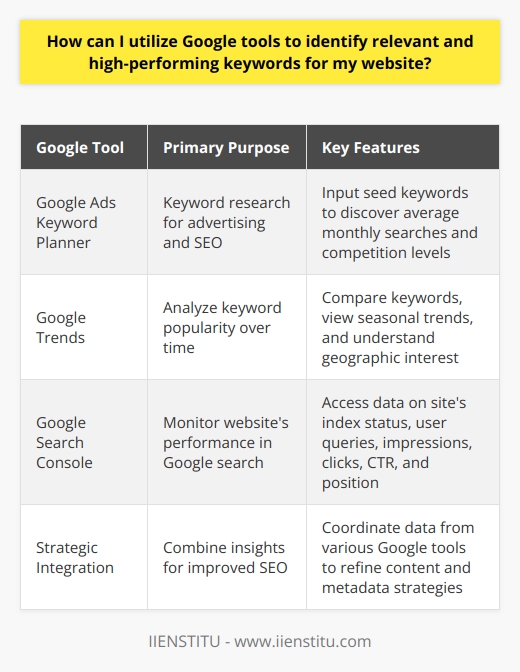
How do you choose relevant keywords for effective search engine optimization?
Identifying the Appropriate Keywords
The process of choosing relevant keywords for effective search engine optimization (SEO) begins with understanding the target audience. Analyzing the needs, interests, and preferences of the potential readers is crucial for keyword selection. Additionally, it is essential to consider the blog's niche and focus topic. By aligning the chosen keywords with the audience's expectations, a blog post can significantly improve its SEO performance.
Using Keyword Research Tools
Various keyword research tools are available to assist in identifying the most effective keywords for SEO. Tools like Google Keywords Planner, SEMRush, and Ahrefs can reveal valuable data such as search volume, competition level, and keyword difficulty. By scrutinizing this data, a blogger can pinpoint the keywords that hold the most potential for driving relevant traffic to their blog post.
Analyzing Competitors' Strategies
Another useful technique for keyword selection is examining the keywords used by successful competitors in the same niche. This analysis can uncover popular keywords and reveal gaps in the competitors' keyword strategy. By utilizing these insights, a blogger can choose keywords that will not only resonate with their target audience but also differentiate their blog content from the competition.
Long-Tail Keywords and LSI Integration
Incorporating long-tail keywords, which consist of phrases containing three or more words, can dramatically impact a blog post's SEO effectiveness. Long-tail keywords usually have lower competition levels and higher chances of ranking in search engine results. Additionally, using Latent Semantic Indexing (LSI) keywords, terms semantically related to the primary keyword, can help search engines better understand the blog post's topic and relevance.
Prioritizing User Experience
When optimizing a blog post, it is imperative to prioritize user experience over search engine algorithms. Content should be informative, engaging, and well-organized, with the keywords incorporated naturally into the text. Any attempt to overstuff keywords can lead to a negative user experience and potentially harm the blog post's search engine ranking.
In conclusion, selecting relevant keywords for effective SEO requires a combination of understanding the target audience, utilizing keyword research tools, analyzing competitors' strategies, and incorporating long-tail and LSI keywords. Moreover, enhancing user experience should remain a top priority throughout the optimization process. By employing these strategies, a blogger can create a well-optimized blog post with the potential to attract more relevant traffic and achieve higher search engine rankings.
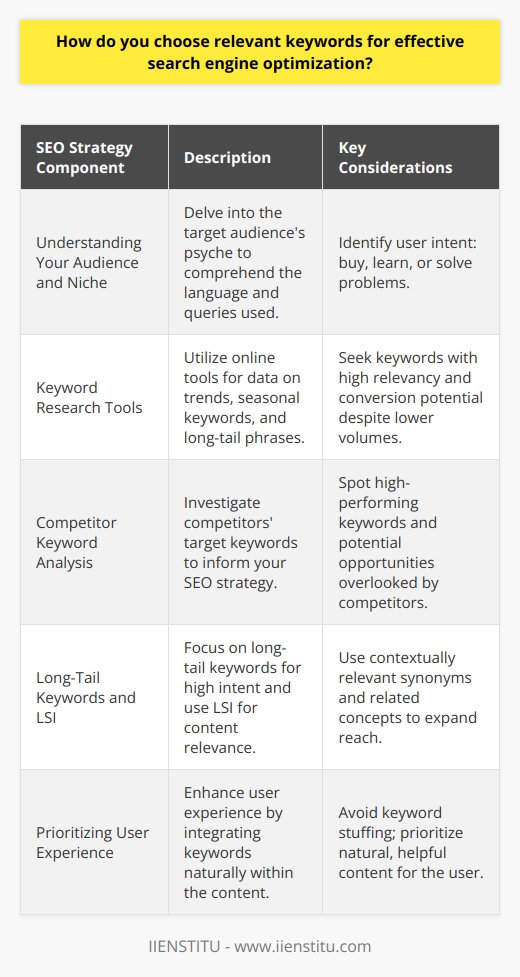
What are the key factors to consider when selecting keywords for optimal SEO performance?
Keyword Selection Criteria
Relevance to Content
The first and foremost factor in selecting keywords is their relevance to the content of the blog post. Keywords must accurately represent the topic and information provided to ensure that users searching for similar content can find it easily.
Search Volume and Competition
Another key factor is the search volume and competition of the keywords. Selecting keywords with high search volume but low competition increases the chances of ranking higher in search engine results pages (SERPs). Using keyword research tools, such as Google Keyword Planner, helps in determining the search volume and competition.
Long-tail Keywords
Incorporating long-tail keywords, which are longer and more specific keyword phrases, can also be beneficial for SEO performance. These phrases have lower search volume but usually have less competition, making it easier to rank higher in SERPs. Additionally, long-tail keywords often target user intent more effectively, leading to increased organic traffic.
Semantic Variations
Consider using semantic variations of the main keywords as well. Search engines, such as Google, increasingly understand the contextual meaning of words. Using synonyms and related terms throughout the blog post may increase its relevancy and visibility to the users.
Localization and Personalization
Localization is a crucial factor when selecting keywords. Using region-specific terms or phrases helps in targeting the local audience and improving site visibility for users in a certain geographic location. Similarly, personalization involves selecting keywords that reflect the interests and preferences of a target audience.
Comprehensive Keyword Analysis
Lastly, conducting comprehensive keyword analysis before finalizing the keywords is critical. This process involves gathering data, such as search volume, competition, and trends, and analyzing it to identify the most effective keywords for the blog post.
In conclusion, selecting the right keywords for optimal SEO performance requires careful consideration of several factors. These include relevance to the content, search volume and competition, long-tail keywords, semantic variations, localization, and personalization. By employing thorough research and analysis for keyword selection, a blog post can have a better chance at achieving higher search engine rankings and attracting more organic traffic.

How do I evaluate the potential impact of chosen keywords on search engine visibility and user engagement?
Keyword Selection and Potential Impact
To evaluate the potential impact of chosen keywords on search engine visibility and user engagement, it is crucial to consider several factors. These can be broken down into keyword competitiveness, search volume, and relevancy to the target audience.
Analyzing Keyword Competitiveness
Competitive analysis involves examining the current rankings of potential keywords in search engine results. This can be achieved by using keyword research tools, such as Google Ads Keyword Planner and Moz's Keyword Explorer, to determine the difficulty score of each keyword. The higher the difficulty score, the more challenging it is to rank higher on search engine results for that keyword. Ideally, one should opt for keywords with a lower difficulty score and high relevance to the blog post content.
Assessing Search Volume
Search volume refers to the number of times users search for a specific keyword in a given time frame. By comparing search volume metrics, one can gauge the popularity and demand of specific keywords. Choosing keywords with a high search volume may lead to increased search engine visibility, thus resulting in higher user engagement. However, it's essential to balance search volume with keyword competitiveness, as high-volume keywords may also be more challenging to rank for.
Evaluating Relevance and Intent
Understanding the target audience's intent and their interests or needs is vital when selecting keywords. Blog posts should contain keywords that align with the audience's search queries and the content's purpose, as this can increase user engagement and retention. To evaluate keyword relevance, one can perform topical research and consider semantic and long-tail keywords, which might be less competitive and more targeted to a specific audience.
Measuring User Engagement
After implementing chosen keywords in a blog post, the final step in evaluating their impact on search engine visibility and user engagement is by periodically analyzing user behavior and performance metrics. Google Analytics and similar tools can provide valuable insights into metrics such as bounce rate, time spent on page, and conversion rates. An improvement in these metrics may signify a positive impact on user engagement, attributable to the chosen keywords and optimization techniques.
In conclusion, effectively evaluating the potential impact of chosen keywords on search engine visibility and user engagement requires careful analysis of keyword competitiveness, search volume, and relevance. Additionally, monitoring user behavior and performance metrics can further elucidate the success of the chosen keywords and optimization strategies.
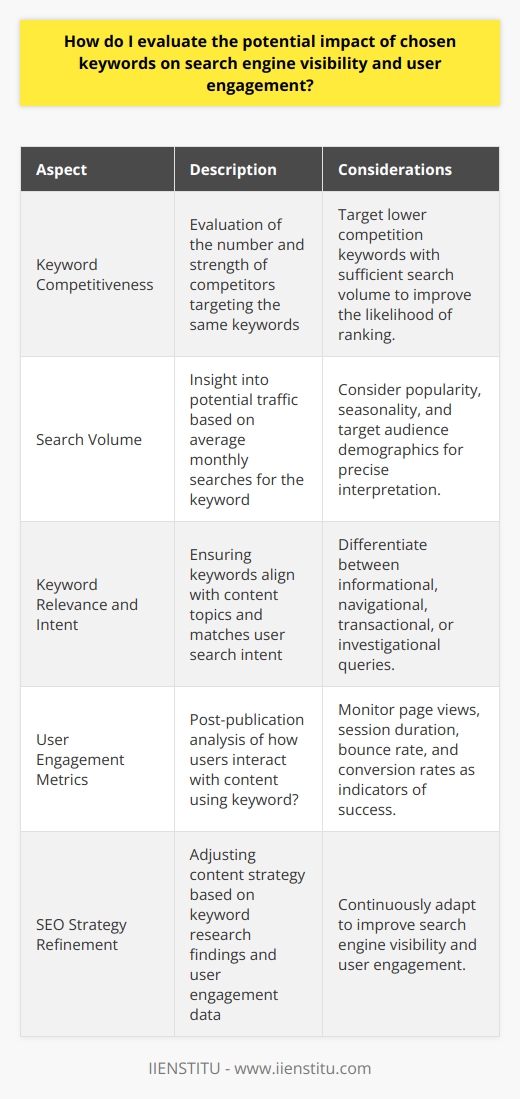
How do you identify keywords for SEO that target specific user intents and improve organic traffic?
Identifying Keywords
To identify SEO keywords that target specific user intents and improve organic traffic, you first need to understand your audience. Know their queries, needs, and how your products or services revolve around their interests. After this understanding, start keyword research.
Keyword Research: A Crucial Step
Keyword research involves using online tools, such as Google AdWords Keyword Planner or SEMrush. These tools will help you find related search queries and their monthly search volumes. Include keywords with a high search volume to capture a wider audience.
Long-tail Keywords: Unleashing the Potential
Go beyond generic ones and integrate long-tail keywords within your content. They're more specific, carry explicit user intent, and lower competition. Consequently, they often lead to higher conversion rates and better rank within specific niche markets.
Analyzing Competition: Understanding the Market
Observe what works for your competitors by examining their target keywords. Tools like Ahrefs can track competitor sites, giving insight into their strategy, and provide ideas for your own keyword optimization.
On-Page SEO: Essential for Organic Traffic
Optimal keyword use demands proper on-page SEO, which includes meta descriptions, title tags, URLs, and content. High-quality content incorporating relevant keywords increases site visibility to search engines and attracts more organic traffic.
Testing and Revising: Continuous Improvement
Finally, keyword strategies demand constant evaluation and revision. Test the effectiveness of your keywords through analytical tools like Google Analytics. If certain keywords are underperforming, revise your keyword strategy.
Overall, effective SEO keyword identification is a multi-step process that requires a profound understanding of your audience, exhaustive keyword research, savvy competition analysis, and frequent revisions based on performance metrics. Remember: SEO is not a one-time set-and-forget activity but an ongoing process.
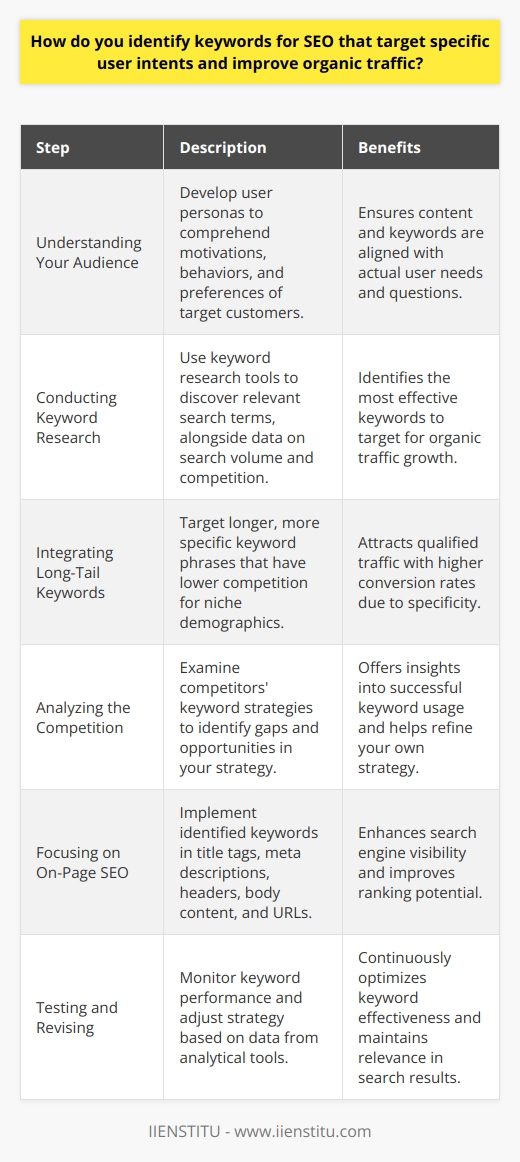
What is the relevance of keywords in SEO for achieving high-quality content and improving user experience?
Keywords in SEO
Keywords play a critical role in Search Engine Optimization (SEO). They serve as the link between what users are searching for and the content you provide to fill that need.
The Importance of Keywords
The accurate usage of keywords leads to high-quality content. In other words, it enhances relevance and clarity. Correct deployment of keyword phrases on your website or blog post increases the likelihood of appearing higher on search engine results.
Keywords and User Experience
Importantly, keywords significantly impact user experience. Effective keyword use helps users locate your content quickly and easily. They also guide the user's navigation on your website, ensuring that they can find relevant content promptly.
Keyword Misuse
However, misuse of keywords can hurt your SEO. Keyword stuffing, or using an excessive amount of keywords in your content, can be counterproductive.
SEO and User Expectations
Achieving the right balance of keywords brings your content in line with user expectations. It enhances readability and engagement. For instance, a blog post that aligns with popular search phrases can draw a larger audience.
Conclusion
To summarise, integrating the right keywords enhances your SEO, improves the quality of your content, and optimizes user experience. Thus, keywords form the backbone of successful, user-oriented SEO strategies. They not only attract web traffic but can also enhance the credibility of your content and overall website. You should consider this in your SEO strategy.

How do I find relevant keywords on Google to create a comprehensive keyword strategy and increase website visibility?
Understanding the Concept of Keywords
An understanding of keywords aids the process. Keywords are specific words or phrases that people frequently use in search engines to look for content. They create a bridge between what people seek online and the content you offer on your website.
Identification of Relevant Keywords
Identify relevant keywords through Google Keyword Planner or Google Trends. These tools provide valuable insights into popular search terms related to your field or topic.
Different Types of Keywords
Consider the different types of keywords. Short-tail keywords consist of 1-2 words, generally have high search volume and competition, and are often broad in scope. Long-tail keywords, on the other hand, are phrases of 3-4 words that are specific to your brand and usually have lower search volume and less competition.
Assessing Keyword Relevance
Assess the relevance of the keywords before integrating them. The best keywords are those closely related to your content, products, or services and align with the intent of your target audience.
Using Keywords in Content
Incorporate these keywords strategically in your content. The aim is not keyword stuffing but natural and meaningful inclusion.
Monitoring Keyword Performance
Constantly monitor how your chosen keywords are performing. Make use of Google Analytics and other keyword tracking tools to measure their effectiveness.
Adjusting Keywords Over Time
Be prepared to adjust your keyword strategy over time. Keywords can change based on trends, seasonality, or changes in your industry or audience behavior.
Perfecting the Keyword Strategy
Perfection of keyword strategy comes with continuous testing and iteration. This will lead to increased visibility of your website and thus, an improved SEO ranking.
To sum up, to create a robust keyword strategy and increase website visibility, you must understand what keywords are, identify relevant ones, understand their different types, assess their relevance, use them strategically in your content, constantly assess their performance, and adjust your strategy as necessary. This iterative process is key to perfecting your keyword strategy.
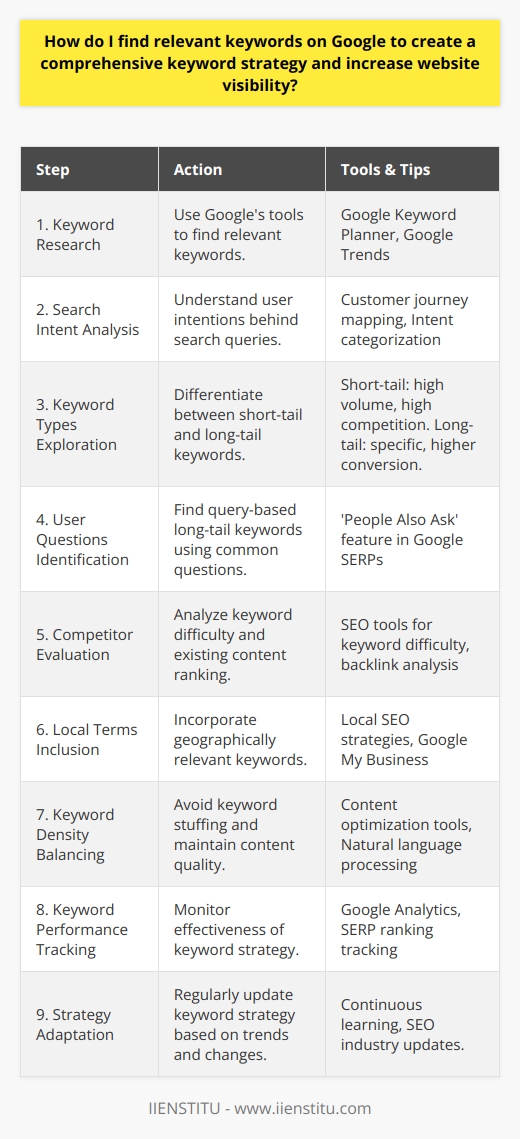
How do you choose relevant keywords in accordance with search intent and user demographics?
Understanding User Intent
Choosing relevant keywords starts by understanding the user's search intent. Search intent refers to the purpose or reason behind a user's internet search. It could be to acquire information, make a purchase, or find a specific website. You can infer this primarily by analyzing popular search terms in your niche and classifying them based on the above categories.
Identifying Demographic Patterns
After understanding search intent, identify demographic patterns among your target audience. Such patterns include age, gender, location, interests, and shopping habits. These demographics influence the search keywords that different users will utilize.
Selecting Target Keywords
Selecting your target keywords involves integrating the above information—search intent and demographics. For instance, younger audiences prefer colloquial phrases, and regional dialects influence location-specific keywords. Using this, you can formulate a list of keywords that mirror your audience's language and intent.
Analyzing Competitor Keywords
Don’t disregard an analysis of your competitors. Assess the keywords they’re using to attract their audience. They may have discovered high-performing keywords that you haven’t considered. Make sure these keywords align with your identified user intent and demographics before adopting them.
Using Keyword Research Tools
Utilizing keyword research tools can be beneficial in finding relevant keywords. Tools like Google Keyword Planner, SEMrush, and Ahrefs propose keywords based on user intent and competitiveness. They offer a wealth of information, including search volume, keyword difficulty, and traffic potential.
Implementing and Monitoring Keywords
After selecting your keywords, embed them naturally into your content. Subsequently, monitor their performance using analytics tools. Do they improve your visibility and drive more traffic? If not, reconsider them. The process of choosing keywords is not static; it requires consistent evaluation and adjustment.
Conclusively, choosing relevant keywords goes beyond guesswork. It requires a deliberate consideration of user search intent, demographics, competitor analysis, keyword research and implementation, and continuous monitoring.
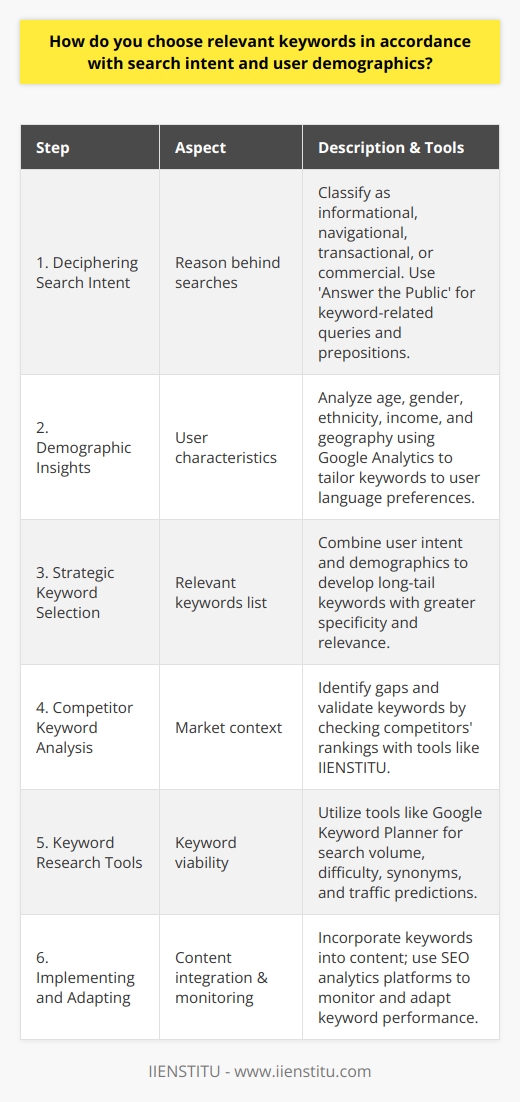
What is the relevance of long-tail keywords in SEO, and how do they differ from short-tail keywords?
The Importance of Long-Tail Keywords
Long-tail keywords constitute a pivotal part of search engine optimization (SEO) strategy. Unlike short-tail keywords, which are typically one or two words, long-tail keywords consist of three or more words. They often encompass specific phrases or questions that users may enter into a search engine.
Distinctiveness in Context
The specificity of long-tail keywords makes them distinct. Their complexity and specificity furthers exact search engine results and boosts user engagement. In contrast, short-tail keywords, due to their brevity, often generate broader and less targeted results.
Impact on Search Traffic
The improved traffic quality given by long-tail keywords enhances site visibility. However, they usually attract lower search volume compared to short-tail keywords. Despite lower search volumes, long-tail keywords have higher conversion rates because they align more closely with user intent.
Significance in Competition
Long-tail keywords play a vital role in SEO due to less competition. With short-tail keywords, websites must compete with larger, more established sites. Using long-tail keywords can alleviate competition, making it easier to vie for top spots in search engine results.
Influence on Content Strategy
Furthermore, long-tail keywords influence content strategy. They guide content creators in producing targeted, relevant content that fulfills specific user needs. This contrasts to short-tail keywords, which lead to more generalized content.
In conclusion, long-tail keywords are significant in SEO as they improve site visibility, increase conversion rates, reduce competition, and guide the development of relevant content. Despite their lower search volume, their benefits make them a crucial tool in any SEO strategy.

How do I find relevant keywords on Google while also considering the competition and search volume for effective SEO results?
Understanding Google Keyword Research
Initiating relevant keyword research on Google entails using various tools that analyze both search volume and competition for these keywords. One tool to efficiently execute this task is Google's Keyword Planner, available with Google Ads. The Keyword Planner offers profound insights about how frequently users search specific keywords and how its search volume changes over time.
Consider Search Volume and Competition
When selecting keywords for your blog post, consider keywords with a higher search volume because they can drive more traffic to your website. However, you must balance this factor with competitiveness. Keywords with a high search volume often have more competition, making it difficult to rank higher in search results.
Use Long-Tail Keywords
In this context, using long-tail keywords, which are longer and more specific keyword phrases, can be beneficial. These keywords tend to have lower competition but can target niche demographics more accurately. Though they might bring in less traffic, it is usually more qualified and engaged.
Incorporate Google Trends
You should also incorporate Google Trends into your keyword research strategy. This tool gives you an idea of the popularity of your chosen keywords over some time. A trending keyword can add traffic to your blog, especially if it aligns with your content.
Leverage the SERP Overview
Lastly, consider using tools like Moz or SEMRush to get an overview of the Search Engine Results Page (SERP) for your chosen keyword. These tools will show you the top ranking sites for that keyword, which can give you insight into the competition and how you can differentiate your content.
In conclusion, understanding and leveraging the tools Google provides enables you to select effective keywords, balancing both search volume and competition. This strategy helps ensure better SEO results for your blog post.



